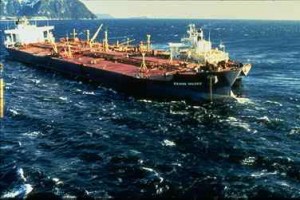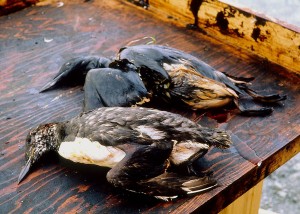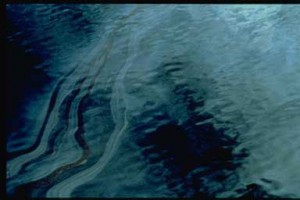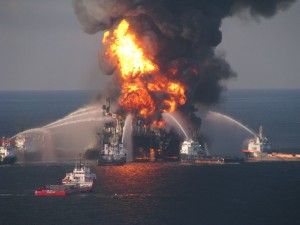
The Exxon Valdez oil tanker after it had run aground. Source:NOAA via Wikimedia Commons.
March 24, 1989: Prince William Sound, Alaska – The Exxon Valdez runs aground Bligh Reef under the supervision of the third mate, while her captain was below deck indulging in liberal libations. Spilling 11 million gallons of crude oil, the disaster was the largest oil spill in American history until the Deep Water Horizon explosion and leak in the Gulf of Mexico in 2010.
In 1995, this writer examined Exxon Mobil’s response to the disaster while in college, presenting a paper documenting the accident in Prince William Sound as also the biggest public relations debacle of its day. When asking Exxon Mobil for their statement, the company provided me with beautiful pictures of Alaska and stated the cleanup was complete with no long term effects to the environment.

Birds killed as a result of oil from the Exxon Valdez spill. Photo courtesy of the Exxon Valdez Oil Spill Trustee Council via Wikimedia Commons.
Nothing could be further from the truth.
Scientists are still discovering the full impact of this disaster. 25 years later, Prince William Sound is still not even close to being the “pristine” environment it once was. In a comprehensive report from NPR, long term effects are being studied revealing alterations in the hearts of fish, reduced survival of marine organisms and disrupted life cycles of sea otters, killer whales and other larger species.
And, 25 years later, the oil industry is no better prepared to deal with the impact of oil spilling ships, ruptured pipelines or other means of transporting crude oil to the market place. The rush is to get the oil out of the ground while drilling the next productive well, raking in billions of profits while investing virtually nothing toward disaster response and cleanup. When all else fails, the oil industry bribes lobbies government representatives and stalls any court settlements through appeals.

During the first few days of the spill, heavy sheens of oil, such as the sheen visible in this photograph, covered large areas of the surface of Prince William Sound. NOAA photo and text (Public Domain) via Wikimedia Commons.
Don’t be discouraged – Exxon Mobil is the world’s largest corporation. They are strategically positioning themselves to continue to swell the size of their profits through an agreement with the Russian oil industry to drill in the oil-rich areas of the arctic. Once those reserves have been depleted, we predict Exxon will force their way back into the Alaskan National Wildlife Refuge (ANWR) by using international agreements such as TPP and TTIP. That is why these agreements are being so vigorously rushed before publics like you and I can object to them.
After all, this is the same corporation that brought us the Mayflower, Arkansas pipeline rupture.
![U.S. Navy Mechanized Landing Craft (LCMs) are anchored along the shoreline as Navy and civilian personnel position hoses during oil clean-up efforts on Smith island. Photo by PH2 POCHE [Public domain], via Wikimedia Commons](http://occupyworldwrites.org/wp-content/uploads/2014/03/1024px-Exxon_Valdez_Cleanup-300x198.jpg)
U.S. Navy Mechanized Landing Craft (LCMs) are anchored along the shoreline as Navy and civilian personnel position hoses during oil clean-up efforts on Smith island. Photo by PH2 POCHE [Public domain], via Wikimedia Commons
25 years ago, the oil industry assured the American public that environmental safety and protection were top priorities. They said they would always clean up any spills, even though they claimed the possibility of those spills were not significant or likely. The Exxon Valdez taught us how negligent these promises were in actual application. When the disaster occurred, most ships used for cleanup were either out of service for maintenance or were totally encased in ice. Supplies and equipment were flown in from Arizona and Texas, since nothing was available in any area close to the spill. The best technologies offered were booms, skimming and shovels or paper towel dabbing on the beaches where oil had soaked the shorelines.

Fire boat response crews battle the blazing remnants of the offshore oil rig Deepwater Horizon. A Coast Guard MH-65C dolphin rescue helicopter and crew document the fire while searching for survivors. Multiple Coast Guard helicopters, planes and cutters responded to rescue the Deepwater Horizon’s 126 person crew. Photo courtesy US Coast Guard (public Domain) via Wikimedia Commons.
25 years later, the best technology for cleaning up spills consists of booms, skimming and shovels or paper towel dabbing on the beaches where oil has soaked the shoreline. Disaster plans presented by all oil companies seeking drilling in the Gulf contained references to protection of wildlife species, such as walruses, needing protection in the Caribbean.
There is not a problem when these corporate giants invest billions into developing better drilling technologies, pipeline building shortcuts and expedition, or lobbying to open public land, national parks and wildlife preserves for oil exploitation. They think nothing of investing funds to secure government inspectors to look the other way while they violate regulations. They have funded the push to abolish the EPA, deregulate the industry and give unrestricted access to federal land.
How can we hold oil and energy companies accountable? When will they take safety seriously? When it impacts their bottom line. When we have the will to pass laws that require these corporations that place our land and water at risk to deposit double the value of their shipments into a superfund used for cleanup – they get it back only after shipments are delivered safely – they might pay closer attention. If they deposit double the cost of a new drill or pipeline project that is held until that well or pipeline is taken out of service, they might care more about leaks and spills.
Until that day arrives, it is cheaper for them to pay insignificant fines and stall litigation than it is for them to act with social and environmental responsibility.
Excited scientists are looking for a species of Caribbean walruses, still undiscovered to this day.






![U.S. Navy Mechanized Landing Craft (LCMs) are anchored along the shoreline as Navy and civilian personnel position hoses during oil clean-up efforts on Smith island. Photo by PH2 POCHE [Public domain], via Wikimedia Commons](http://occupyworldwrites.org/wp-content/uploads/2014/03/1024px-Exxon_Valdez_Cleanup-300x198.jpg)
